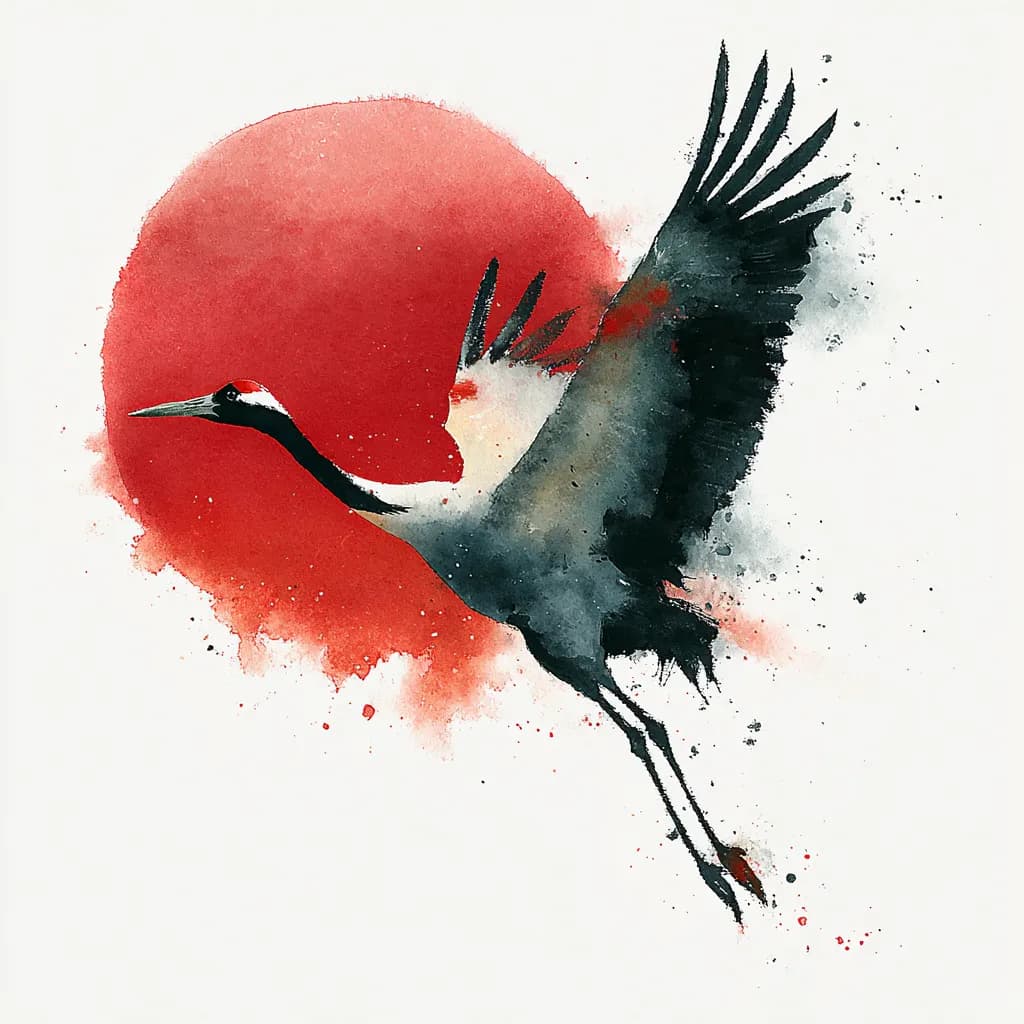
Sumi-e Inspired Watercolor Red-Crowned Crane
Prompt
A Sumi-e inspired watercolor portrayal of a red-crowned crane in flight, blending traditional East Asian ink wash techniques with modern watercolor splashes. Use primarily black and grey with accents of vibrant red for a minimalist yet expressive composition.
What Makes This Sumi-e Crane Watercolor Special?
This unique AI prompt creates a distinctive fusion of traditional East Asian Sumi-e ink wash techniques with contemporary watercolor artistry, specifically focusing on the elegant red-crowned crane in flight. Unlike typical bird artwork, this prompt emphasizes the philosophical depth of Sumi-e painting - where negative space and minimal brushstrokes convey maximum emotional impact. The combination of traditional calligraphic techniques with modern watercolor splashes creates a bridge between ancient artistic wisdom and contemporary visual expression, making it perfect for artists seeking authentic cultural representation with modern appeal.
The prompt's strength lies in its ability to capture the crane's symbolic significance in East Asian culture while maintaining artistic authenticity. The red-crowned crane represents longevity, wisdom, and grace in traditional symbolism, and this prompt ensures these cultural elements are preserved while creating visually stunning artwork suitable for both traditional art enthusiasts and modern design applications.
Visual Elements Breakdown
This Sumi-e crane watercolor prompt incorporates several sophisticated visual techniques that distinguish it from standard bird artwork:
-
Calligraphic Brushwork: The prompt emphasizes flowing, calligraphic strokes that mimic traditional Sumi-e techniques, where each brushstroke carries intentional meaning and energy. This creates dynamic movement lines that suggest the crane's graceful flight path and spiritual essence.
-
Color Harmony Strategy: The carefully balanced color palette of black, grey, and vibrant red creates visual tension and cultural authenticity. The black ink represents the traditional Sumi-e foundation, grey tones provide depth and atmosphere, while the red accents highlight the crane's distinctive crown and add symbolic significance.
-
Watercolor Integration: Modern watercolor splashes are strategically incorporated to add contemporary artistic flair without overwhelming the traditional aesthetic. These organic, bleeding effects create natural texture and movement that complements the structured ink work.
-
Negative Space Mastery: The prompt emphasizes minimal backgrounds and negative space utilization, following traditional East Asian composition principles where emptiness becomes an active design element that enhances the subject's presence and emotional impact.
Style Variations and Customization
This Sumi-e crane prompt offers numerous creative possibilities for artists seeking to explore East Asian artistic traditions:
-
Seasonal Adaptations: Transform the composition by adding seasonal elements like cherry blossoms for spring, autumn leaves for fall, or snowflakes for winter, each maintaining the minimalist aesthetic while adding contextual storytelling.
-
Medium Experimentation: While optimized for watercolor, the prompt can be adapted for digital painting, traditional ink on rice paper, or mixed media approaches that preserve the Sumi-e philosophy while exploring contemporary techniques.
-
Cultural Context Expansion: Enhance the cultural depth by incorporating traditional East Asian landscape elements like bamboo, mountains, or traditional architecture as subtle background elements that complement rather than compete with the crane.
-
Symbolic Enhancement: Add traditional East Asian symbols like clouds, waves, or geometric patterns that carry specific cultural meanings, creating layered artwork that appeals to both aesthetic appreciation and cultural understanding.
Professional Applications
This Sumi-e crane watercolor prompt serves diverse professional and creative markets:
-
Cultural Art Galleries: Perfect for exhibitions focusing on East Asian art traditions, contemporary interpretations of classical techniques, or cross-cultural artistic dialogue between traditional and modern approaches.
-
Educational Institutions: Ideal for art schools teaching traditional East Asian techniques, cultural studies programs exploring artistic heritage, or workshops introducing students to Sumi-e philosophy and watercolor integration.
-
Commercial Design: Suitable for luxury brands seeking sophisticated cultural imagery, wellness and meditation centers requiring serene, meaningful artwork, or hospitality venues wanting authentic East Asian aesthetic elements.
-
Art Therapy and Wellness: The prompt's emphasis on mindfulness, cultural depth, and serene beauty makes it valuable for therapeutic art programs, meditation spaces, or wellness-focused design projects that benefit from meaningful, calming imagery.
Advanced Techniques
Mastering this Sumi-e crane watercolor prompt requires understanding both traditional and contemporary artistic principles:
-
Brushstroke Mastery: Focus on creating varied brushstroke weights and directions that suggest the crane's movement and energy flow, using traditional Sumi-e principles where each stroke carries intentional meaning and emotional expression.
-
Color Balance Optimization: Experiment with different ratios of black, grey, and red to achieve optimal visual harmony, understanding that traditional Sumi-e often uses limited color palettes to maximize emotional impact and cultural authenticity.
-
Composition Refinement: Study traditional East Asian composition principles like the rule of thirds, asymmetrical balance, and the use of negative space to create artwork that feels both culturally authentic and visually compelling.
-
Cultural Sensitivity: Research the symbolic meanings of cranes in East Asian culture, understanding how to represent these elements respectfully while creating artwork that appeals to contemporary audiences seeking authentic cultural experiences.